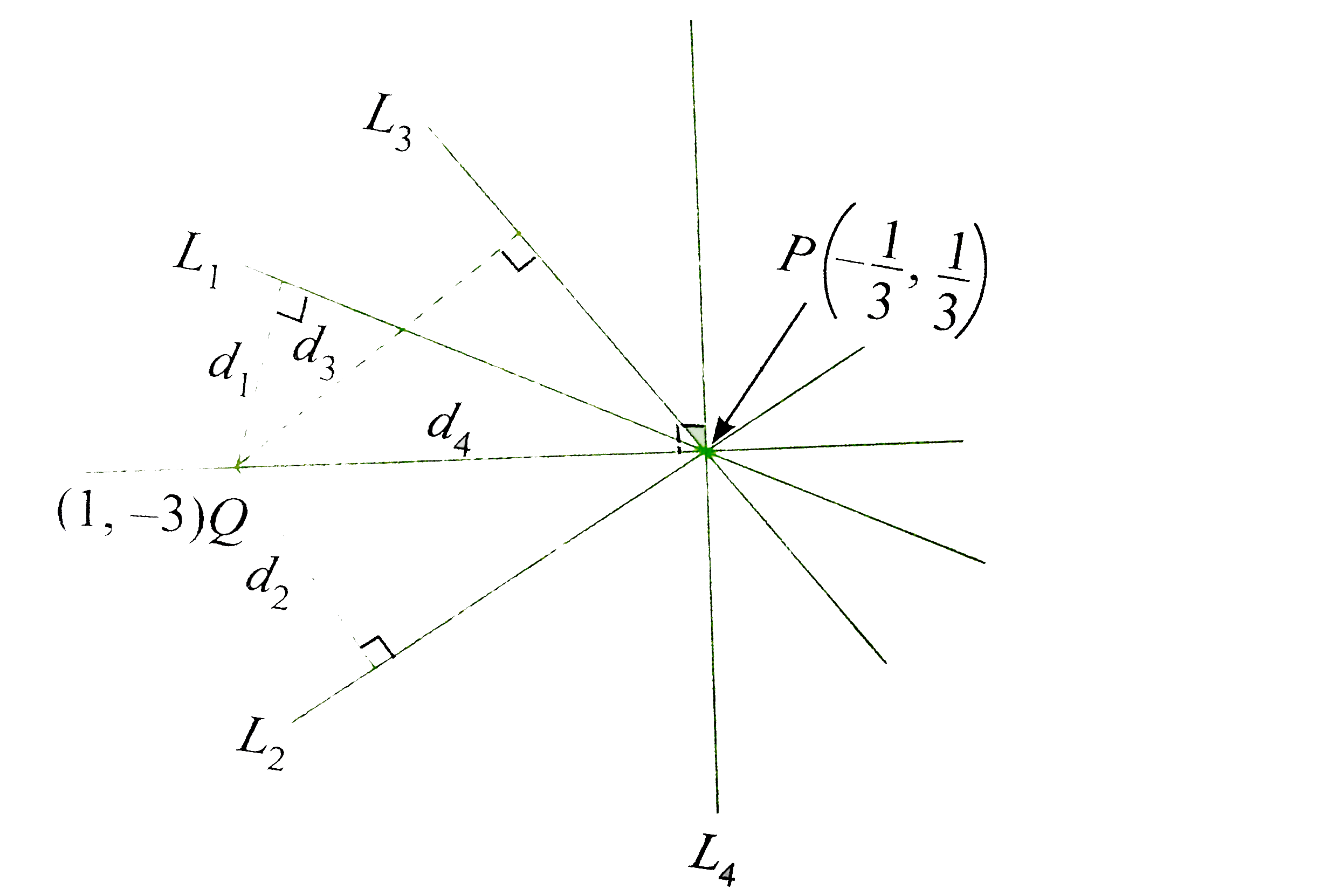Consider a family of straight lines (x+y)+λ(2x−y+1)=0 . Find the equation of the straight line belonging to this family that is farthest from (1,−3).Solution in Bengali

Given lines are concurrent at point of intersection of lines x+y=0and2x−y+1=0 which is P(−13,13).
We require a line through point P which is farthest from point Q(1,-3), i.e., line whose perpendicular distance from point P is the greatest.
We observe that perpendicular distances d1,d2,d3..... of the lines L1,L2,L3....., respectively, from point Q are less than distance d4 of the line L4 Q. Line L4 is perpendicular to the segment joining P and Q. Line L4 is the greatest distance from point Q.
Slope of PQ is mPQ=−3−131+13=−52
Slope of the line L4=25
Therefore, equation of the required line is
y−13=25(x+13)
or 6x-15y+7 = 0
Topper's Solved these Questions
- BOOK - CENGAGE PUBLICATIONCHAPTER - STRAIGHT LINESEXERCISE - EXAMPLE12videos
STRAIGHT LINES
- BOOK - CENGAGE PUBLICATIONCHAPTER - STRAIGHT LINESEXERCISE - CONCEPT APPLICATION EXERCISE 2.123videos
STRAIGHT LINES
- BOOK - CENGAGE PUBLICATIONCHAPTER - STRAIGHT LINEEXERCISE - Multiple Correct Answers Type8videos
STRAIGHT LINE
- BOOK - CENGAGE PUBLICATIONCHAPTER - THEORY OF EQUATIONSEXERCISE - JEE ADVANCED (Numerical Value Type )1videos
THEORY OF EQUATIONS
Similar Questions
Show that the lines 4x+y−9=0,x−2y+3=0,5x−y−6=0 make equal intercepts on any line of slope 2.
04:16View SolutionFind the equation of the right bisector of the line segment joining the points (3,4) and (-1,2).
07:31View SolutionThe point P(α,α+1) will lie inside the triangle whose vertices are A(0,3),B(−2,0) and C(6,1) if
04:33View SolutionThe number of distinct real roots of x4−4x3+12x2+x−1=0is_____.
05:31View SolutionConsider a family of straight lines (x+y)+λ(2x−y+1)=0 . Find the equation of the straight line belonging to this family that is farthest from (1,−3).
03:08View SolutionConsider a family of straight lines (x+y)+λ(2x−y+1)=0 . Find the equation of straight line belonging to this family that is farthest from (1;-3)
05:51View SolutionConsider the family of lines 5x+3y−2+λ1(3x−y−4)=0 and x−y+1+λ2(2x−y−2)=0. Find the equation of a straight line that belongs to both the families.
03:43View SolutionConsider the family of lines 5x+3y−2+λ(3x−y−4)=0 and x−y+1+μ(2x−y−2)=0 Equation of straight line that belong to both families is ax+by−7=0 then a+b is
04:43View SolutionConsider the family of line (x+y−1)+λ(2x+3y−5)=0 and (3x+2y−4)+μ(x+2y−6)=0 Equation of a straight line that belongs to both the families is:
06:36View SolutionConsider the family of lines 5x+3y−2+λ(3x−y−4)=0andx−y+1+μ(2x−y−2)=0. The equation of a straight line that belonges to both the families is
09:15View SolutionConsider a family of straight lines (x+y)+λ(2x−y+1)=0 . Find the equation of the straight line belonging to this family that is farthest from (1,−3).
06:45View SolutionConsider a family of straight lines (x+y)+λ(2x−y+1)=0 . Find the equation of the straight line belonging to this family that is farthest from (1,−3).
04:46View SolutionConsider the family of lines 5x+3y−2+λ1(3x−y−4)=0 and x−y+1+λ2(2x−y−2)=0. Find the equation of a straight line that belongs to both the families.
04:04View SolutionConsider the family of lines 5x+3y−2+λ1(3x−y−4)=0andx−y+1+λ2(2x−y−2)=0. Equation of a straight line that belong to both families is
01:51View SolutionIf a family of straight line (x+y)+λ(2x−y+1)=0. Find the equation of the staright line belonging to this family that is farthest from (1,-3).
04:22View SolutionConsider the family of lines (x+y−1)+λ(2x+3y−5)=0 and (3x+2y-4)+μ(x+2y−6)=0, equation of a straight line that belongs to both the families is
05:07View Solution

